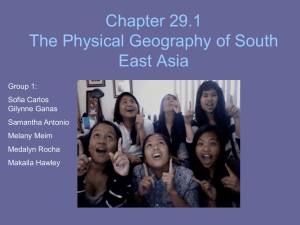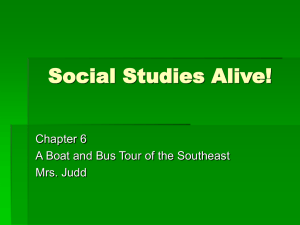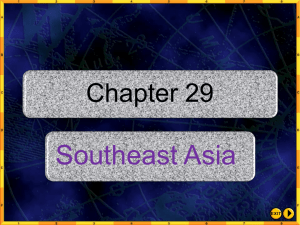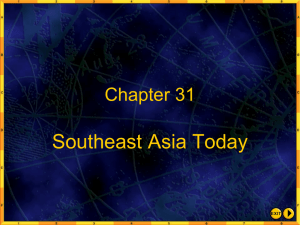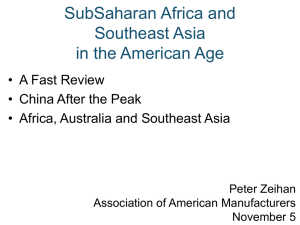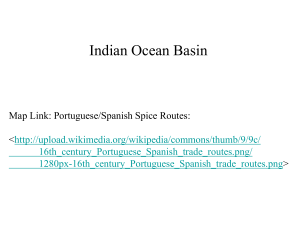Chapter 25 - Burnet Middle School
advertisement
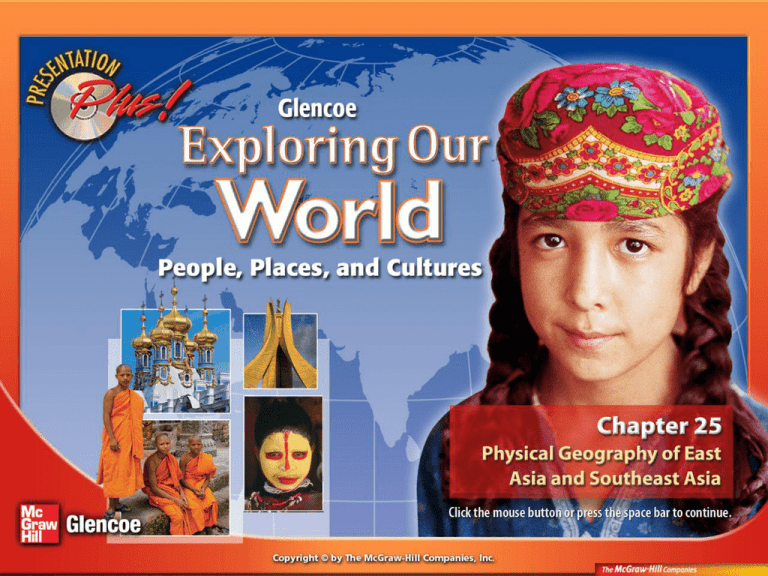
Chapter Introduction Section 1: Physical Features Section 2: Climate Regions Visual Summary Human-Environment Interaction About 2 billion people, or roughly one-third of the world’s population, live in the region of East Asia and Southeast Asia. The region is also one of the most densely populated areas in the world. What factors do you think influence where people live? Section 1: Physical Features Physical processes shape Earth’s surface. The movement of Earth’s tectonic plates helped shape the landscape of East Asia and Southeast Asia. Today, plate movements cause dangerous earthquakes and volcanoes along the region’s Pacific Rim. Section 2: Climate Regions Geographic factors influence where people settle. Some areas in East Asia and Southeast Asia have very dry climates that support little farming. The region also has areas with plentiful rainfall and rich soil. These agriculturally productive areas are some of the most populous places on Earth. Physical processes shape Earth’s surface Content Vocabulary • archipelago • gorge • cordillera • tungsten • loess • teak Academic Vocabulary • despite • construct Traveling on a river is part of life for people in Laos. The Nam Song River is a tributary of the mighty Mekong River that runs through Southeast Asia. More than 60 million people depend on the river system for food, water, and economic survival. People are concerned, however, that China’s plans to build dams along the Mekong will hurt the region’s communities and wildlife habitats. Read Section 1 to learn more about the physical features of East Asia and Southeast Asia. What do you think most endangers water supplies in your community? A. Pollution B. Global warming C. Overuse D. Don’t know 0% A A. B. C. 0% D. B A B C 0% D C 0% D The Huang He (Yellow River) actually dried up in the 1990s before it could reach the sea. While China has been building large new cities along the Huang He’s shores in the hope of attracting business, industry, and people, it has taken more and more water from the river. Pollution has been massive. Global warming has slowed the natural replenishment of the river. With so many damaging variables combined, the river isn’t quite the river it was. The Land Tectonic plate movements have created mountains and caused powerful earthquakes in parts of the region. The Land (cont.) • East Asia and Southeast Asia extend from the mountains of inland China westward to the Pacific shores of Japan, and north to south from the highlands of northeastern China to the tropical islands of Indonesia. The Land (cont.) • East Asia occupies much of the Asian continent south of Russia. • China and Mongolia extend over most of East Asia’s landmass. • The other East Asian countries—North Korea, South Korea, Japan, and Taiwan— lie on peninsulas or islands. The Land (cont.) • Mountain ranges and highlands slice through western East Asia. – The tallest ranges here include the Himalaya and the Kunlun Shan. – Between these mountains is the vast Plateau of Tibet, averaging about 15,000 feet (4,572 m) in elevation. The Land (cont.) • East of the mountains are East Asia’s only major lowland areas—the North China Plain and the Manchurian Plain. • Narrow lowland areas also line the coasts of the Korean Peninsula and Japan. • Most of East Asia’s population lives on these fertile lowland areas. The Land (cont.) • In the Pacific Ocean off East Asia’s coast lies an arc of mountainous islands. – These islands include Japan, which forms an archipelago, or chain of islands, and Taiwan off the coast of southeastern China. – Indonesia and the Philippines are also archipelagoes. The Land (cont.) – East Asia’s islands are part of the Ring of Fire, an area bordering the Pacific Ocean where plate movements cause many earthquakes and volcanic eruptions. The Land (cont.) • From north to south, mainland Southeast Asia is crossed by cordilleras, or mountain ranges that run side by side. – Fertile river plains and deltas separate the ranges. – These lowland areas are home to most of mainland Southeast Asia’s people. The Land (cont.) • South and east of mainland Southeast Asia are many mountainous islands which form part of the Ring of Fire and hold many active volcanoes. • Despite their dangers, they provide rich soil that supports agriculture. The Land (cont.) • The islands of Southeast Asia also face challenges from earthquakes. • An earthquake on the Indian Ocean floor in 2004 caused a tsunami that washed over the coastal lowlands of more than a dozen countries, killing more than 300,000 people and destroying thousands of homes and businesses. Which country lies entirely on Southeast Asia’s mainland? A. Indonesia B. Malaysia C. Thailand D. Philippines 0% A A. B. C. 0% D. B A B C 0% D C 0% D Seas and Rivers Seas and rivers play an important role in agriculture and trade in the region. Seas and Rivers (cont.) • The most important rivers in East Asia flow through China, beginning in the Plateau of Tibet and flow eastward to the Pacific Ocean. • The Huang He (Yellow River) is northern China’s major river system. – This river carries tons of fine, yellowbrown soil called loess that blows in from deserts in western China. Seas and Rivers (cont.) – When deposited, the rich soil—along with the river’s water—makes the North China Plain a major wheat-growing area. – Throughout China’s history, the Huang He has regularly flooded the land, destroying homes and drowning many people. Seas and Rivers (cont.) • China’s Chang Jiang (Yangtze River) is Asia’s longest river, flowing about 3,400 miles through spectacular gorges and broad plains until it empties into the ocean at Shanghai. – The Chang Jiang provides water for a large farming area where more than half of China’s rice and other grains grow. – It is also an important trade route allowing oceangoing ships and barges to travel far upriver. Seas and Rivers (cont.) • The Chinese are constructing a the world’s largest dam—the Three Gorges Dam—on the Chang Jiang, intended to prevent floods and supply a large amount of hydroelectric power. Seas and Rivers (cont.) • Southeast Asia’s major rivers begin in northern highlands and in southern China. • Most of them flow southward toward the Gulf of Thailand, which is an arm of the South China Sea. Seas and Rivers (cont.) • Southeast Asia’s major rivers include the Irrawaddy and the Salween in Myanmar and the Chao Phraya in Thailand. • The Mekong River begins in China and empties into the South China Sea. • Warm temperatures and heavy rains make the Mekong region a fertile ricegrowing area. Which river in East Asia carries tons of fine, yellow-brown soil called loess? A. Huang He B. Chang Jiang C. Huang Jiang D. Strait of Malacca 0% A A. B. C. 0% D. B A B C 0% D C 0% D A Wealth of Natural Resources The region’s valuable resources support its growing economies. A Wealth of Natural Resources (cont.) • China, Indonesia, Brunei, Malaysia, and Vietnam have rich oil reserves. • Major coal producers are China, Indonesia, North Korea, South Korea, Japan, the Philippines and Vietnam. A Wealth of Natural Resources (cont.) • China produces electricity from the Three Gorges Dam on the Chang Jiang. • Dams on Japan’s swift, short rivers provide hydroelectric power for that country’s cities, industries, and farms. A Wealth of Natural Resources (cont.) • Indonesia, Malaysia, and China are leading producers of tin. • China has one of the largest iron ore deposits in the world. • North Korea, Vietnam, Malaysia, Indonesia, and the Philippines also mine iron ore. A Wealth of Natural Resources (cont.) • Chromium, manganese, nickel, and tungsten, which are used to make highquality steel, are found in China and the Philippines. • Tungsten is also used to make light bulbs and rockets. A Wealth of Natural Resources (cont.) • Myanmar, Indonesia, and Thailand have large quantities of teak wood, which is used to make buildings and ships because it is strong and durable. • Mahogany from the Philippines is used in wall paneling and high-quality furniture. Which gem is harvested in Japan? A. Diamonds B. Pearls C. Rubies D. Sapphires 0% A A. B. C. 0% D. B A B C 0% D C 0% D Geographic factors influence where people settle. Content Vocabulary • dzud • landslide Academic Vocabulary • series • site The rafflesia is the largest––and maybe the smelliest––flower in the world. The rafflesia is a type of lily that grows in the rain forests of Malaysia and Indonesia. The flower measures up to 3 feet (1 m) wide and gives off the smell of rotting meat to attract flies that pollinate it. Rafflesia and other flowers in this region are used to make lifesaving medicines. Read Section 2 to learn more about East Asia and Southeast Asia’s climate and vegetation. Are there any similarities between the climate zones of East Asia and the climate where you live? A. Yes B. No C. Maybe D. Don’t know 0% A A. B. C. 0% D. B A B C 0% D C 0% D In the middle of China’s Taklimakan Desert, archaeologists have discovered a city they say is 2,200 years old. The most surprising feature is that practically the whole city was built of wood from poplar trees. With satellite technology, scientists can tell that the area once had plenty of water and forests. They speculate that the city died and the desert took over partly because the people cut all the trees—what we today call deforestation. Effects on Climate Wind patterns influence the climates in East Asia and Southeast Asia. Effects on Climate (cont.) • Winds, along with the region’s landforms, shape the climates of East Asia and Southeast Asia. • In winter, cold Arctic winds sweep across flat areas of Siberia and lower temperatures in Mongolia and northern China. • The average January temperature around Ulaanbaatar, Mongolia’s capital, is about –15°F (–26°C). Effects on Climate (cont.) • In the vast parts of the region that lie below northern China, monsoon winds are common. • In the summer, warm, moist Pacific air brings as much as 80 percent or more of the region’s yearly rainfall. • In the winter, dry winds blow outward from the Asian continent to the ocean. Effects on Climate (cont.) • Areas of Southeast Asia that are closest to the Equator have warm temperatures year-round. • Rain falls more evenly there throughout the year. Effects on Climate (cont.) • Ocean currents also affect climate, especially on islands such as Japan. – A warm-water current flows north along southeastern Japan, adding moisture to the winter monsoon as it warms the land. – A cold current flows southwest along Japan’s Pacific coasts, bringing harsh, cold winters to Japan’s northernmost areas. Effects on Climate (cont.) • The warm waters of the Tropics help form strong, hurricane-like storms called typhoons. • Typhoons that arise in the Pacific can blow across coastal East Asia, causing much damage with their high winds, large waves, and heavy rains. What is a strong, hurricane-like storm in the Pacific? A. Monsoon B. Typhoon C. Tsunami D. Earthquake 0% A A. B. C. 0% D. B A B C 0% D C 0% D Climate Zones East Asia generally has middle latitude climates like those in the United States, while Southeast Asia has mostly tropical climates. Climate Zones (cont.) • The climate is dry in the northern and far western parts of East Asia. – In summer, dry continental air blows across Asia from the west. – In winter, cold Arctic air from the north also carries little moisture. Climates of East Asia and Southeast Asia Climate Zones (cont.) – In addition, monsoon winds from the Pacific have released all their moisture by the time they reach inland areas. Climates of East Asia and Southeast Asia Climate Zones (cont.) • Most of Mongolia and northern China receives only enough rain to create a steppe climate that supports livestock with extensive grasslands. • Some years a small amount of rain falls, and summers are dry. • The weather pattern of a dry summer followed by a harsh winter is called a dzud. Climate Zones (cont.) • Mongolians fear dzud conditions because dry summers decrease the available food for their herds. Climate Zones (cont.) • Northeastern China, the northern part of the Korean Peninsula, and northern Japan have humid continental climates with warm summers and cold winters. • The rest of East Asia and the northern part of Southeast Asia have a humid subtropical climate. Climate Zones (cont.) • Much of Southeast Asia lies in the Tropics. – It receives the direct rays of the sun in the summer, making temperatures very warm. – In winter, warm air from the Equator blows over the area, keeping temperatures warm. Climate Zones (cont.) • Though sites, or locations, near the Equator are generally warmer, sea breezes help keep coastal temperatures more moderate. • Altitude also keeps temperatures low in tropical areas. • In the mountains that cross the islands of Borneo and New Guinea, temperatures can be quite cold. Climate Zones (cont.) • Rains can be heavy in the tropical rain forest climate region. • Parts of Indonesia receive as much as 120 inches (305 cm) per year. • Large amounts of rain can fall in a single day—as much as 28 inches (71 cm). Climate Zones (cont.) • Abundant rains support the growth of tropical rain forests, home to a tremendous variety of plants and animals. • Malaysia’s rain forests alone contain more than 14,000 species of flowering plants. • Deforestation is taking the region’s rain forests at a rapid rate. • Thailand has lost nearly half of its forest in less than 40 years. Climate Zones (cont.) • Deforestation has contributed to natural disasters such as landslides. – Landslides are when heavy rains soak treeless hillsides. – Soil is washed down the hills, sometimes burying villages in mud and killing villagers. Climate Zones (cont.) • Mountain areas in Indonesia and southwestern China, including the Himalaya and the Plateau of Tibet, have highland climates. – Temperatures in these areas tend to be cool and drop even more in the mountains. – Because these areas receive dry continental air, they tend to have dry landscapes. What type of climate do northeastern China, the northern part of the Korean Peninsula, and northern Japan have? A. Humid continental 0% D A D. Tropical 0% A B C0% D C C. Dry continental A. B. C. 0% D. B B. Humid subtropical Landforms • The region’s tallest mountains lie in the western parts of East Asia. • Most East Asians live in coastal lowland plains. • Southeast Asia includes a mainland of peninsulas and thousands of islands. • Areas of East Asia and Southeast Asia lie along the Ring of Fire and can experience volcanoes and earthquakes. Seas and Waterways • Oceans and seas provide important shipping routes as well as supplies of fish for food. • China’s major rivers—the Huang He (Yellow) and the Chiang Jiang (Yangtze)— support farming but also produce floods. • The Chinese have built the Three Gorges Dam on the Chang Jiang to prevent flooding and to provide hydroelectric power. Natural Resources • Oil deposits are found in China, Malaysia, and Indonesia. • China has iron ore and coal deposits that support its steel industry. • Southeast Asia’s tropical rain forests provide valuable woods, such as teak and mahogany. Climates • Three dominant air masses affect climate in much of East Asia and Southeast Asia. • Monsoons bring seasonal rainy or dry conditions to some parts of the region. • Ocean currents affect climate, especially on islands such as those of Japan. archipelago group of islands cordillera region of parallel mountain chains loess fine-grained fertile soil deposited by the wind gorge like a canyon, a steep-sided valley formed when a river cuts through land that is being lifted upward tungsten metal combined with iron to make steel, also used to make the filaments in electric lightbulbs and parts of rockets that must resist high amounts of heat teak high-quality wood used to make buildings and ships because it is strong and durable despite in spite of construct to build dzud weather pattern in Mongolia in which a harsh winter follows a dry summer landslide disaster that occurs when soil is washed down steep hillsides due to an earthquake or heavy rain series arranged in an order and alike in some way site location To use this Presentation Plus! product: Click the Forward button to go to the next slide. Click the Previous button to return to the previous slide. Click the Home button to return to the Chapter Menu. Click the Transparency button from the Chapter Menu, Chapter Introduction, or Visual Summary slides to access the transparencies that are relevant to this chapter. From within a section, click on this button to access the relevant Daily Focus Skills Transparency. Click the Return button in a feature to return to the main presentation. Click the Geography Online button to access online textbook features. Click the Reference Atlas button to access the Interactive Reference Atlas. Click the Exit button or press the Escape key [Esc] to end the chapter slide show. Click the Help button to access this screen. Links to Presentation Plus! features such as Graphs in Motion, Charts in Motion, and figures from your textbook are located at the bottom of relevant screens. This slide is intentionally blank.
